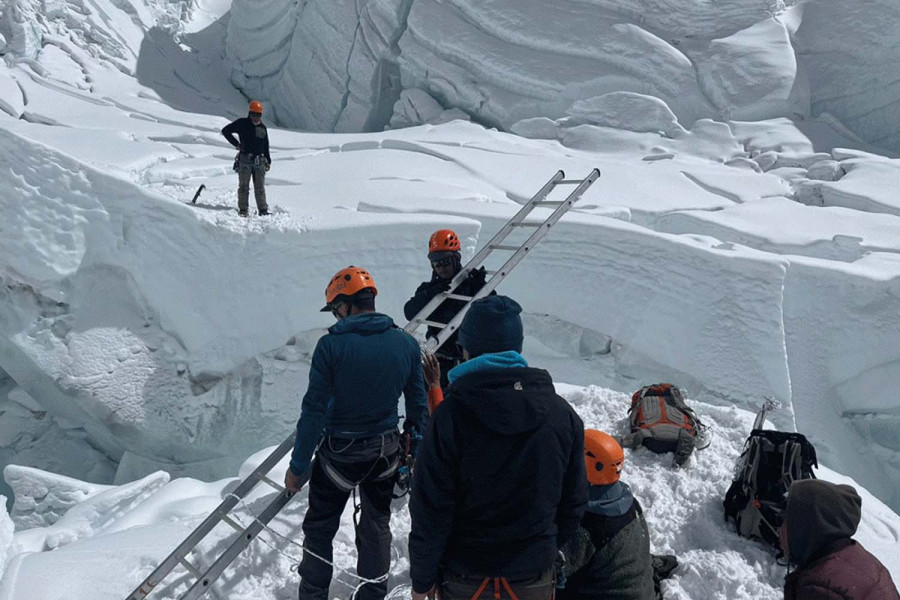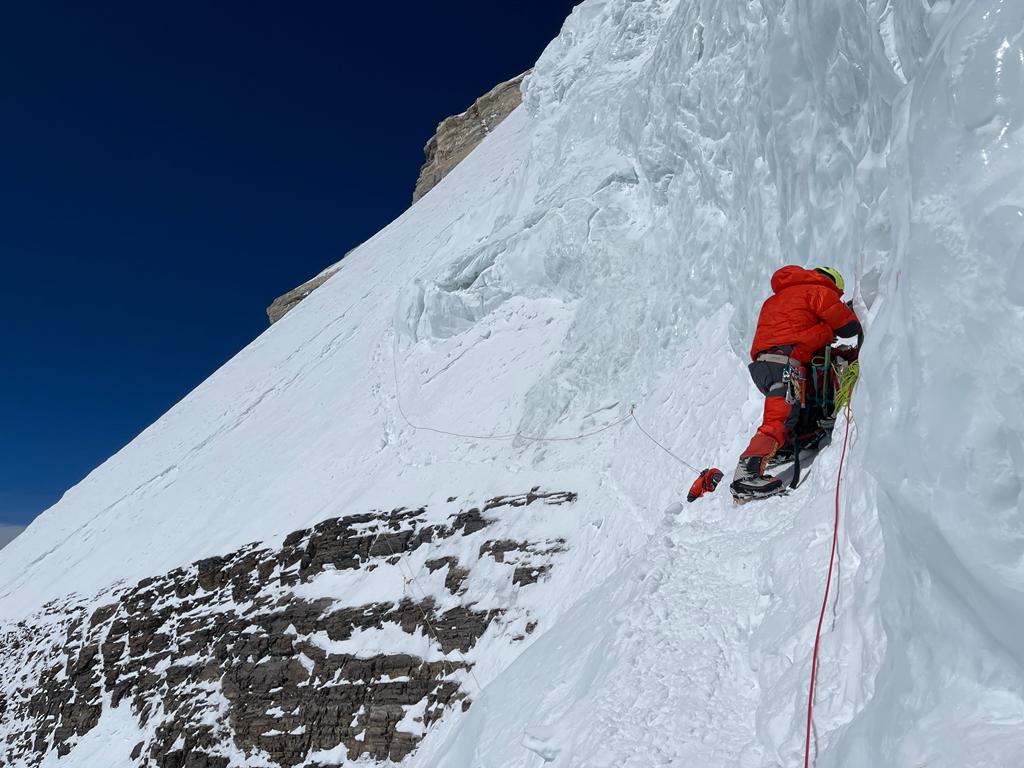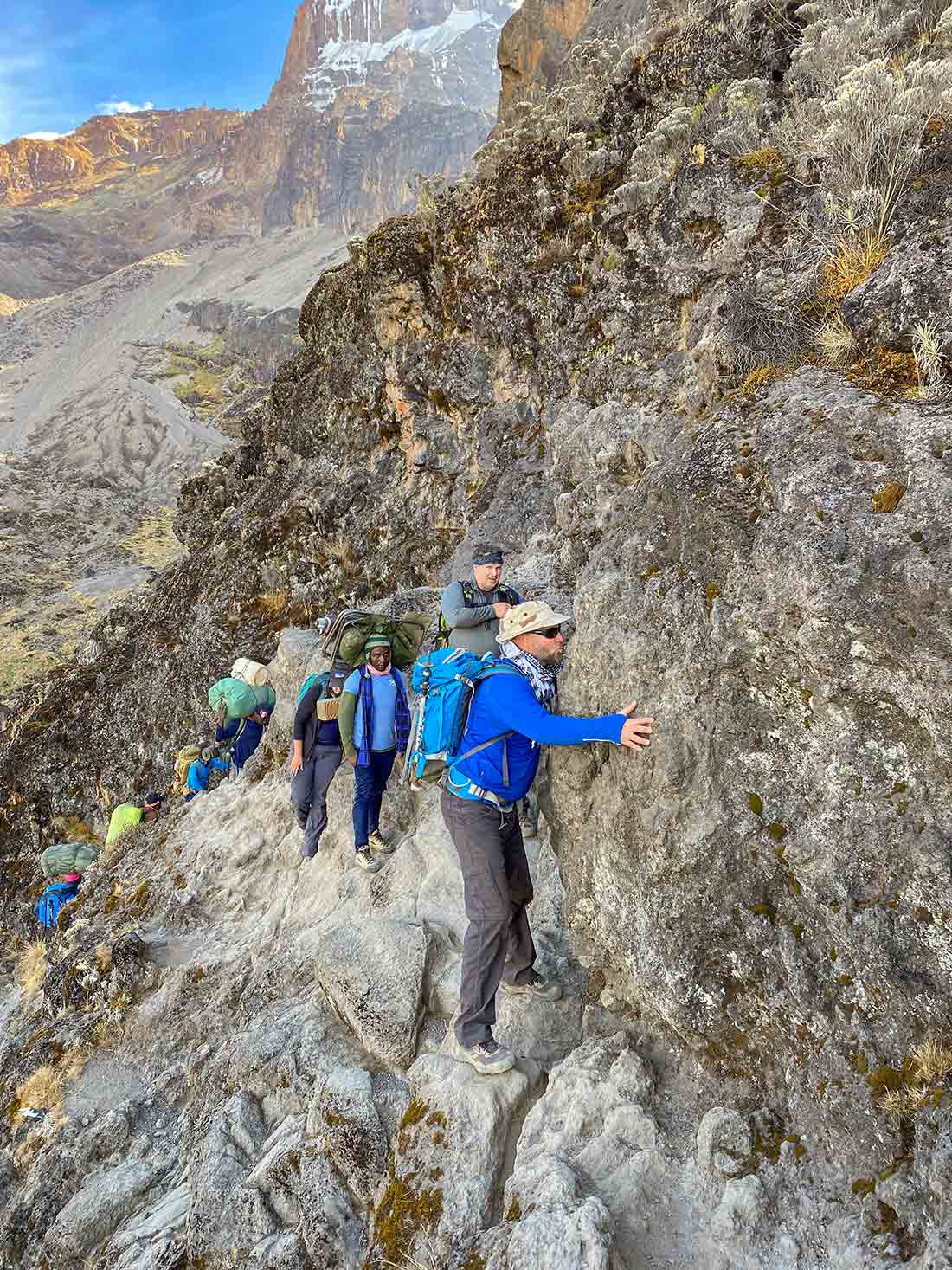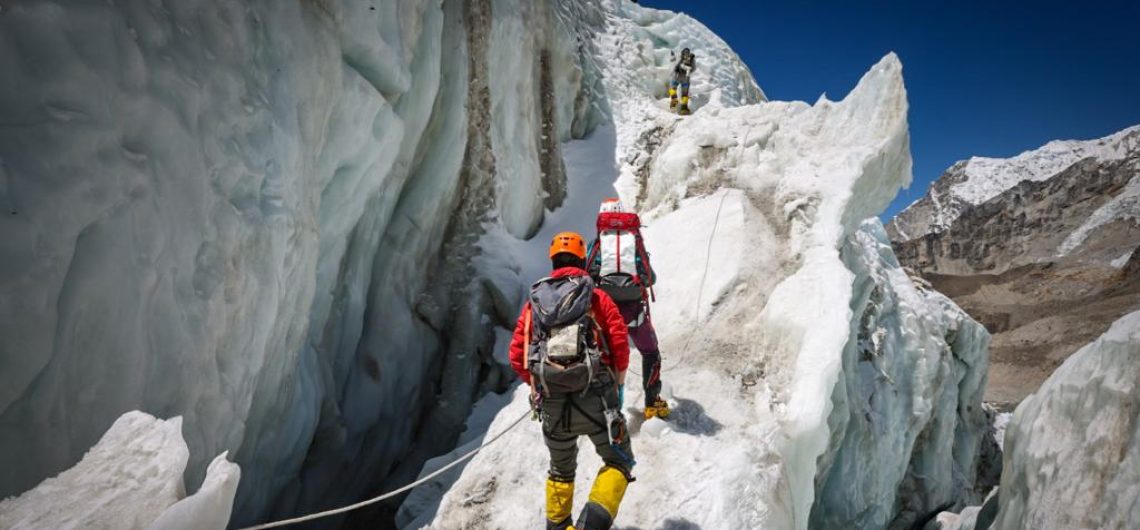Everest’s Khumbu Icefall, K2’s Bottleneck, and Barranco Wall (also known as the kissing rock) are renowned and challenging sections found on three of the world’s most formidable mountains. While both locations pose significant obstacles to climbers, each has its own unique characteristics and demands.
The Khumbu Icefall on Mount Everest, K2’s Bottleneck, and Kilimanjaro’s Barranco Wall each present unique and formidable challenges to climbers. While the Khumbu Icefall is characterized by its ever-changing ice formations, the Bottleneck demands technical expertise and precise decision-making. On the other hand, the Barranco Wall tests climbers’ physical stamina and scrambling skills on Kilimanjaro. Despite their differences, these sections serve as reminders of the unforgiving nature of these majestic mountains, requiring mountaineers to demonstrate skill, resilience, and respect for the forces of nature as they embark on their quests for summit success.
Everest’s Khumbu Icefall vs K2’s Bottleneck
Scaling the majestic summits of Mount Everest or K2 stands as the pinnacle aspiration for innumerable avid mountaineers. Yet, surmounting the zenith of these two loftiest peaks of the world demands much more than mere words can convey.
Spanning over a period of seven to eight weeks, both expeditions entail a substantial investment of approximately $45,000 (K2) to $60,000 (Everest) on average. The significance of this temporal and monetary commitment cannot be overstated, emphasizing the indispensability of comprehensive training and meticulous packing prior to embarking on the journey to Kathmandu or Islamabad.
Read, how much does it cost to climb Mount Kilimanjaro?
While the prerequisites in terms of gear and physical preparation bear a resemblance for conquering both summits, it is widely acknowledged that K2 poses a more formidable and perilous challenge compared to Everest.
Nevertheless, the pursuit of either peak carries inherent perils, as is the case with most mountain expeditions. The Khumbu Icefall on Everest and the Bottleneck on K2 serve as particularly hazardous segments along the treacherous paths.
These distinct features present a plethora of hazards that climbers must negotiate, with debates persisting regarding which one holds greater danger.
Some contend that the Khumbu Icefall surpasses the Bottleneck of K2 in terms of treacherousness, attributing this viewpoint to its considerable length and inherent unpredictability but in our opinion, the Bottleneck is riskier.
The Khumbu Icefall, situated at the pinnacle of the Khumbu Glacier and the base of the Western Cwm, sits at an elevation of 5,486 meters (17,999 feet).
Extending four kilometers (2.5 miles) in length, the Khumbu Glacier, as it recedes rapidly from Everest Base Camp, bequeaths an arduous icefall in its wake.
Most guides regard the Khumbu Icefall as the most hazardous segment along the South Col Route due to the gradual yet constant descent of the icefall down the mountain.
Each passing day witnesses the Khumbu Icefall shifting downward by an estimated 0.9 to 1.2 meters (3 to 4 feet), which brings forth unforeseen crevasses and precipitates the collapse of seracs—enormous ice towers ranging in size from a refrigerator to a house.
The Khumbu Icefall lies at a relatively lower altitude, enabling swift ascents without the need for supplemental oxygen, “Only specific sections of the Khumbu Icefall are vulnerable to avalanches or the crumbling of seracs. By promptly identifying these regions and proceeding expeditiously, one can rest in safe pockets.”
It is gravity that renders the Khumbu Icefall the most hazardous section of any Everest expedition.
The movement of the glacier mass gives rise to the collapse of seracs. This precarious eventuality is not contingent upon temperature or weather conditions and can transpire at any time of the day or night.
In addition, there exists a potential threat of seracs collapsing and snow avalanches originating from Everest’s west shoulder and Nuptse, which frequently reach the climbing route in the Khumbu Icefall.
The majority of climbers endeavor to traverse the icefall prior to daybreak, when the ice remains partially frozen owing to the frigid nighttime temperatures, thus exhibiting reduced flow.
Seasoned mountaineers are generally able to navigate through the Khumbu Icefall within a few hours, thereby minimizing their exposure to the perils it harbors. However, less experienced climbers have been known to spend 10 to 12 hours crossing this treacherous terrain.
As the day progresses, the intensifying sunlight causes the ice to warm, thereby reducing the friction within the glacier and accelerating the movement of the icefall.
By commencing the ascent in darkness and colder temperatures, one can mitigate the risks associated with temperature-induced incidents to some extent. However, gravity-induced incidents remain an ever-present peril.
Given that the ice is in constant motion, the structure of the glacier undergoes perpetual transformations. Consequently, the locations and dimensions of crevasses continually change. While many crevasses are discernible and avoidable, newly formed or expanded ones may lurk beneath snow bridges, presenting the possibility of climbers falling through.
Even with the extensive network of ropes and ladders installed each climbing season by the ice doctors, the Khumbu Icefall remains the most hazardous segment of any Everest expedition.
The key to traversing the Khumbu Icefall lies in swiftness and resting solely in safe zones,
The K2 Bottleneck, positioned along the Southeast Spur Route (also known as the Abruzzi Spur) at 8,200 meters (26,900 feet), lies a mere 400 meters (1,300 feet) from the summit.
A narrow couloir, flanked by seracs, characterizes the Bottleneck, which extends along the periphery of the ice field to the east of the summit. This passage is inescapable, as all four primary routes necessitate crossing it to reach the pinnacle.
To surmount the Bottleneck, climbers must execute a traverse with a daunting gradient of 50 to 60 degrees while being exposed to the looming threat of serac collapse for a distance of 100 meters (330 feet). The high altitude further exacerbates the enormity of this challenge.
The K2 Bottleneck is situated at a substantially higher elevation, resulting in a slower pace for climbers, and a reduced pace entails prolonged exposure.
According to Furtenbach, the combination of altitude and slope renders the Bottleneck the most perilous segment of the world’s most lethal mountain.
The entire route below the overhanging serac, including the traverse and the final ascent slope, is susceptible to falling ice. Such incidents can occur at any time, day or night. The couloir itself, the traverse, and even the ultimate ascent slope pose a significant risk of slab avalanches.
As per Karrar Haidri, the secretary of the Pakistan Alpine Club, K2 has claimed the lives of approximately 90 climbers. The Bottleneck, in particular, became the site of a disastrous climbing accident in 2008 when a massive chunk of the ice shelf fractured, resulting in the loss of 11 lives.
Drawing comparisons between the Khumbu Icefall and the Bottleneck, the latter presents climbers with a significantly higher degree of risk than the former but still, both segments entail substantial danger.
I would evaluate the risk associated with the K2 Bottleneck as more unmanageable in comparison to that of the Khumbu Icefall. Yet, it remains crucial to recognize that both are inherently perilous, and one can meet a fatal fate in either without any errors in judgment.
Khumbu Icefall: Everest’s Frozen Maze
The Khumbu Icefall is a notoriously hazardous section on the southern route to the summit of Mount Everest. Situated between Everest Base Camp and Camp I, the icefall is a jumble of massive ice blocks, towering seracs, and deep crevasses. It is known for its unpredictable nature and ever-changing terrain, making it a constant source of concern and danger for climbers.

Key Features:
- Ice Seracs: Towering ice formations, some as high as a multi-story building, are scattered throughout the Khumbu Icefall. These seracs are prone to collapse and can create treacherous conditions for climbers.
- Crevasses: Deep and wide cracks in the ice, known as crevasses, pose a significant threat in the icefall. They are often concealed beneath thin snow bridges, making navigation perilous.
- Ladders and Fixed Lines: To negotiate the icefall, climbers rely on a network of aluminum ladders and fixed ropes. These aid in crossing crevasses and provide some stability on the unstable terrain.
Challenges:
- Instability: The Khumbu Icefall is constantly shifting and changing due to the movement of the Khumbu Glacier. This makes the route hazardous, as climbers must navigate through unstable ice formations.
- Avalanche Risk: The icefall is prone to frequent avalanches, triggered by the collapse of seracs or the movement of ice blocks. Climbers must carefully time their ascent to minimize exposure to this risk.
- Time Constraints: The icefall is best traversed during the early morning when the temperature is colder, reducing the chances of ice collapse. This requires climbers to make an early start and ascend swiftly to reach safer ground before the sun’s heat increases the risk.
K2’s Bottleneck: The Narrow Gauntlet
K2’s Bottleneck is a treacherous and technically challenging section on the Abruzzi Spur route of K2, the second-highest peak in the world. Situated at an altitude of approximately 8,200 meters (26,900 feet), the Bottleneck is a narrow and steep passage that demands precision, endurance, and careful decision-making.

Key Features:
- Steep Gradient: The Bottleneck is a steep and icy section, requiring climbers to ascend at a demanding angle. The terrain is unforgiving and necessitates the use of specialized climbing techniques and equipment.
- Rockfall Hazard: Loose rocks and unstable ice formations pose a constant threat in the Bottleneck. Climbers must exercise caution to avoid potential rockfall and minimize the risk of accidents.
- Altitude and Oxygen Deprivation: At this high altitude, the thin air and reduced oxygen levels significantly impact climbers’ physical performance, making even simple tasks exhausting and mentally taxing.
Challenges:
- Technical Difficulty: The Bottleneck presents climbers with a combination of steep ice slopes and exposed rock sections. The technical difficulty of this passage requires climbers to possess advanced mountaineering skills, including proficiency in ice climbing and efficient rope management.
- Limited Space and Congestion: The narrowness of the Bottleneck can lead to congestion, particularly during the peak climbing season. Climbers must navigate the passage carefully, coordinating with others to ensure safe passage and avoid bottlenecks.
- Unpredictable Weather: K2 is notorious for its unpredictable and severe weather conditions. Rapid changes in weather can further amplify the challenges in the Bottleneck, with high winds, extreme cold, and sudden storms posing additional risks to climbers.
Barranco Wall: Kilimanjaro’s Rocky Obstacle
The Barranco Wall is a striking geological feature found on the Machame Route of Mount Kilimanjaro in Tanzania. While not as high in altitude as Everest or K2, it presents a formidable challenge due to its steepness, rugged terrain, and exposure.
 Key Features:
Key Features:
- Volcanic Rock: The Barranco Wall is composed of volcanic rock, featuring large boulders, rocky outcrops, and sections that require climbers to scramble and negotiate steep inclines.
- Scenic Views: Despite the arduous nature of the ascent, climbers are rewarded with breathtaking panoramic views of Kilimanjaro’s surrounding landscapes, including the expansive Barranco Valley below.
- Strategic Route Choices: The Barranco Wall offers multiple routes and options for climbers to ascend, allowing them to choose the path that best suits their abilities and comfort levels.
Challenges:
- Steep Inclines: The Barranco Wall presents climbers with steep inclines that require physical exertion and careful footwork. The ascent demands both strength and endurance, testing climbers’ fitness levels.
- Altitude Effects: Although not as extreme as in the higher peaks, the effects of altitude can still be felt on Kilimanjaro. Climbers must be mindful of potential altitude sickness and acclimatize properly during their ascent.
- Technical Scrambling: Sections of the Barranco Wall involve technical scrambling, where climbers need to use their hands and feet to maneuver over rocks and challenging terrain. This requires a good sense of balance and confidence in scrambling techniques.
Similarities between Everest’s Khumbu Icefall, K2’s Bottleneck and Kilimanjaro’s Barranco Wall
While the Khumbu Icefall, K2’s Bottleneck, and Kilimanjaro’s Barranco Wall have their unique characteristics, there are a few similarities among these challenging sections:
- Technical Difficulty: All three sections demand a certain level of technical skill and expertise from climbers. Negotiating the steep gradients, navigating through crevasses or rocky terrain, and using proper climbing techniques are essential in safely traversing these sections.
- Physical Demands: Climbing the Khumbu Icefall, Bottleneck, or Barranco Wall requires climbers to be in good physical condition. The steep inclines, rocky surfaces, and altitude effects place significant strain on the body, necessitating strength, endurance, and overall fitness.
- Hazards and Risks: Each section poses its own set of hazards and risks. Whether it’s the unpredictable ice collapses and avalanches in the Khumbu Icefall, the potential for rockfall in the Bottleneck, or the challenges of scrambling on the Barranco Wall, climbers must be aware of the dangers and take appropriate precautions.
- Altitude Effects: While Everest and K2 are known for their extreme altitudes, even Kilimanjaro’s Barranco Wall is subject to the effects of higher elevations. Climbers may experience symptoms of altitude sickness, including shortness of breath, fatigue, and headaches. Proper acclimatization and adherence to altitude protocols are crucial.
- Mental Resilience: Successfully tackling these sections requires mental fortitude. Climbers must remain focused, make critical decisions, and manage fear and anxiety in high-stress situations. The ability to stay calm, adapt to changing circumstances, and maintain a positive mindset is vital for overcoming the challenges.
Despite their similarities, it’s important to recognize that each section possesses its own unique characteristics and demands. Climbers should thoroughly research, prepare, and equip themselves accordingly for the specific challenges they will encounter on their chosen mountain.
Which is the hardest to climb?
In our opinion, K2’s Bottleneck is harder to navigate between these three sections. Determining which section is harder—Khumbu Icefall, K2’s Bottleneck, or Kilimanjaro’s Barranco Wall—is subjective and depends on various factors. Each section presents its own set of challenges and difficulties. Here’s a brief comparison:
- Khumbu Icefall: The Khumbu Icefall is known for its constantly shifting ice formations, deep crevasses, and towering seracs. It requires climbers to navigate through a hazardous maze of unstable ice and negotiate ladders over crevasses. The ever-changing nature of the icefall, coupled with the risk of avalanches, adds to the difficulty. Altitude effects and extreme weather conditions also contribute to the challenge.
- K2’s Bottleneck: The Bottleneck on K2 is a narrow couloir situated near the summit. It involves steep, icy slopes with exposed sections and a high risk of rockfall. Climbers must carefully maneuver through this technically demanding section, often using fixed ropes and making precise decisions. The extreme altitude, severe weather, and objective dangers make the Bottleneck a formidable challenge.
- Kilimanjaro’s Barranco Wall: The Barranco Wall on Kilimanjaro is a steep and rocky section on the Machame Route. While it may not have the same altitude as Everest or K2, it requires climbers to scramble over volcanic rocks and navigate through challenging terrain. The physical exertion and endurance required, coupled with the effects of altitude, make it a demanding ascent.
Comparing the difficulty of these sections is subjective and depends on individual experience, skills, and personal preferences. The technical demands of the Bottleneck and the ever-changing hazards of the Khumbu Icefall make them particularly challenging. However, the altitude effects and physical demands of the Barranco Wall should not be underestimated.
Ultimately, climbers should thoroughly research and understand the specific challenges posed by each section, assess their own abilities and experience, and make informed decisions based on their goals and comfort levels.
FAQs
Here are some frequently asked questions related to climbing Mount Everest and K2:
Q: How long does it take to complete expeditions to Mount Everest and K2?
A: Both expeditions typically require between seven and eight weeks to complete.
Q: What is the average cost of climbing Mount Everest and K2?
A: The average cost is around $45,000 for K2 and $60,000 for Everest.
Q: Are the gear requirements and physical training similar for climbing both peaks?
A: Yes, the gear lists and physical training are similar for climbing Mount Everest and K2.
Q: Which mountain is considered more technically challenging and dangerous?
A: K2 is widely regarded as a more technically challenging and dangerous mountain to climb than Everest.
Q: What are the most dangerous sections of Mount Everest and K2?
A: For Everest, the Khumbu Icefall is considered the most dangerous, while the Bottleneck is the challenging section on K2.
Q: What makes the Khumbu Icefall dangerous?
A: The Khumbu Icefall is dangerous due to the slow but steady movement of the icefall down the mountain, leading to crevasses and falling seracs.
Q: Why is the Bottleneck on K2 considered hazardous?
A: The Bottleneck on K2 is perilous because climbers must traverse a narrow couloir exposed to the risk of serac collapse and slab avalanches.
Q: How many climbers have died on K2?
A: Approximately 90 climbers have lost their lives on K2, with one of the deadliest incidents occurring at the Bottleneck in 2008.
Q: Is the risk greater at the Khumbu Icefall or the Bottleneck?
A: According to experts, the Bottleneck on K2 presents a higher degree of risk compared to the Khumbu Icefall, although both sections are dangerous.
Q: Can climbers die on Mount Everest or K2 even without making mistakes?
A: Yes, both mountains carry inherent risks, and fatalities can occur without any errors in judgment.
Please note that climbing these mountains is extremely challenging and should only be attempted by experienced mountaineers with proper training and support.
![]()


Comments